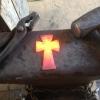-
Posts
475 -
Joined
-
Last visited

Old South Creations replied to reddog176's topic in Blacksmithing, General Discussion

Old South Creations replied to Sam Salvati's topic in Slitters, Punches, Drifts, etc

Old South Creations replied to divermike's topic in Blacksmithing, General Discussion

Old South Creations replied to jmccustomknives's topic in Metal Sculpture & Carvings

Old South Creations replied to viking6764's topic in Anvils, Swage Blocks, and Mandrels

Old South Creations replied to viking6764's topic in Anvils, Swage Blocks, and Mandrels

Old South Creations replied to AZtrapper's topic in Solid Fuel Forges

Old South Creations replied to Old South Creations's topic in Anvils, Swage Blocks, and Mandrels

Old South Creations replied to Old South Creations's topic in Anvils, Swage Blocks, and Mandrels

Old South Creations replied to territorialmillworks's topic in Blacksmithing, General Discussion
